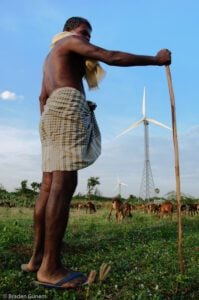As the world grapples with the grave threat of climate change, the voluntary carbon market (VCM) has emerged as a policy tool in the global effort to reduce greenhouse gas emissions. But what role does sustainable development play in the VCM?
While the VCM is primarily concerned with climate action, sustainable development is a concept holistically covering social, environmental and economic sustainability. Nevertheless, the VCM, despite the controversy surrounding it, should carry the concept of sustainable development at its heart. While it is not hard to find supporters of this idea, the real challenge lies in the implementation and integration of sustainable development in the VCM today.
Carbon markets and climate action

The Kyoto Protocol, adopted in 1997, marked a significant milestone in the political fight against global heating. It introduced the concept of national emissions trading, allowing countries to buy and sell emissions allowances as a means of reducing greenhouse gas emissions.
The flawed Clean Development Mechanism (CDM), a central feature of the Kyoto Protocol, was established to encourage “developed” countries to finance emission reduction projects in “developing” nations. The dual objective was to help industrialised countries meet their emission reduction targets while promoting sustainable development in the host countries.
However, the CDM faced criticism and challenges, ranging from pricing issues and methodological loopholes to concerns about negative social and environmental impacts. As highlighted by CMW before, the CDM failed to live up to its promise of delivering both emissions reductions and social benefits.
The birth of the voluntary carbon market
In response to these criticisms and the need for a more flexible approach to carbon trading, the VCM emerged in the early 2000s. Led by the private sector, this mechanism was driven by companies’ need to manage their reputations as public pressure mounted for them to take climate action.
One of the key features of the voluntary carbon market is its flexibility, which allows it to adapt quickly to global transitions and trends. Unlike compliance markets, the VCM is not bound by stringent regulations, giving it the freedom to explore innovative approaches to carbon trading. This adaptability, however, is both a strength and a weakness. While it allows the VCM to experiment with new methods and foster corporate sustainability, it also introduces a degree of unpredictability and leaves room open for private actors to pursue their own self-interest, which often did not coincide with that of the planet.
The unregulated nature of the VCM creates challenges. It allows companies to claim carbon neutrality without standardised and universally accepted criteria, undermining the other positive environmental and social contributions that projects deliver in their respective areas. This lack of consistency in the objective of the VCM is a source of concern. There are instances of companies that are more interested in the mere appearance of sustainability than in genuine emissions reductions and sustainable development.
Chicken and egg story
In 1989, the first private sector voluntary carbon offsetting agreement was made between the global power company AES and the NGO CARE. AES was looking for a project that would offset the emissions created by the construction and operation of a new power plant in continental America. The project, an ongoing afforestation activity in Guatemala, had the initial objective to alleviate poverty until it received funding from AES. Thereafter, it became the first project explicitly aimed at the offsetting of emissions. This switch in objective shifted the allocation of project related resources to carbon accounting and left local stakeholders to contend with catastrophic negative consequences.
The AES-CARE agreement is just one of the many examples of unregulated voluntary attempts to offset emissions, and the problems they created, before VCM standards existed. Sustainable development in these projects was not a priority.
In the years that followed, the first attempts to regulate these voluntary carbon projects emerged. In 1994, Plan Vivo, a partnership between the University of Edinburgh, El Colegio de la Frontera Sur and other local partners, piloted the carbon offsetting project Scolel’te in Mexico, with the aim of helping local communities plant trees. Soon after, they officially traded in “carbon credits”.
In the aftermath of a harsh wave of criticism in the late 1990s and early 2000s towards the CDM with regards to its sustainable development reporting and monitoring, and growing demand for social and environmental benefits accounting, several NGOs kickstarted collaborations in the early 2000s and founded voluntary carbon standards that were supposed to deliver better results than the CDM .
The CDM Gold Standard (today’s Gold Standard), the CCBA (today’s CCB Standard under Verra) and other newly founded crediting standards required project developers to report, first, on the Millenium Development Goals and, then, on the Sustainable Development Goals.
In addition to VCM actors, governmental bodies, too, engaged in carbon trading and the prioritisation of sustainable development. In 2003, the European Union reacted to the criticism of human rights abuses connected to some CDM projects by introducing regulatory checks to prevent harm to local communities. In 2006, the British government set up the Government Carbon Offsetting Fund that would support only those projects contributing to social and economic sustainable development.
It’s clear that the VCM grapples with the enigma of its true objectives, whether they lean more towards the social or environmental, or the purely economic self-interest. Deciphering between authentic positive contributions and greenwashing remains a pressing challenge.
Sustainable development and the VCM today
The utilisation of the Sustainable Development Goals (SDGs) as a benchmark for gauging the impact of emission reduction projects is a significant step towards aligning the VCM with global sustainability objectives. However, this approach is not without its challenges.
The SDGs are a global tool, tailored for national application. The translation from the national policy level to the VCM project level is a risky endeavour in which initial values and objectives might get lost. For instance, if a project developer interprets SDG 1 (No Poverty) in purely economic terms using monetary value, but ignores other indicators of welfare, the project’s true impact may be distorted, which puts the overall positive or negative contributions of VCM projects at risk going undetected.
Another ongoing debate centres around the quantity versus the quality of SDGs claimed by projects. While quantitative measurement is important for assessing the overall impact of VCM initiatives, prioritising quantity over quality could inadvertently undermine the essence of sustainable development. If project A claims to be contributing to all 17 SDGs, and project B to only two, the buyer really does not know which project is of higher quality.
The standardisation of measurement, coupled with the introduction of quality thresholds, can provide a middle ground that encourages projects to prioritise meaningful contributions over merely accumulating SDGs. But can the SDGs even be standardised at the project level and which should be given priority?
The requirement for standardised reporting and measurement in the VCM could potentially result in unintended consequences, as social and environmental SDGs sometimes involve trade-offs on the project-level that demand careful consideration. Striking the right balance between pursuing multiple SDGs while ensuring their contextual relevance is crucial.
Should the sustainability dimension of VCM projects be primarily focused on social or environmental targets, or assign an equal balance to both?
Acknowledging the complexity of the VCM, where actors with diverse backgrounds and priorities come together, is critical to resolving this ambiguity. But one thing should be clear: even though trade-offs exist between the SDGs, carbon markets must, under no circumstance, lead to human suffering or create environmental damage.
If it is to fulfil its perceived role as climate and sustainability tools, the voluntary carbon market must not only demonstrate a clear benefit to the climate, it must do so while advancing the interests of local communities and host countries. After all, sustainable development is all about humanity thriving in a healthy environment.
Further reading
This article is based on Benja’s MSc thesis (‘The Institutionalisation of Sustainable Development in the Voluntary Carbon Market – an institutional analysis’) submitted in May 2022 at Wageningen University & Research.
Sources used in this article
- Headon, S (2009). ‘Whose sustainable development sustainable development under the Kyoto Protocol, the Coldplay effect, and the CDM Gold Standard’, Colorado Journal of International Environmental Law and Policy, 20(2), pp127–156.
- Lang, C (2009, December 14), ‘How a forestry offset project in Guatemala allowed emissions in the USA to increase‘, REDD-Monitor.
- Michaelowa, A, Espelage, A., & Hoch, S. (2020), ‘Co-benefits under the market mechanisms of the Paris Agreement‘, in W. Buchholz Et Al. (Ed.), Ancillary Benefits of Climate Policy (pp51–66), Springer Climate.
- Scherer, L, Behrens, P, de Koning, A, Heijungs, R, Sprecher, B, & Tukker, A (2018), ‘Trade-offs between social and environmental Sustainable Development Goals‘, Environmental Science & Policy, 90, pp65–72
- Schneider, LR (2007), ‘Is the CDM fulfilling its environmental and sustainable development objectives? An evaluation of the CDM and options for improvement‘, WWF.
- Wittman, HK, & Caron, C (2009). ‘Carbon offsets and inequality: social costs and co-benefits in Guatemala and Sri Lanka‘, Society & Natural Resources, 22(8), pp710–726.
Author
-

Benja Faecks works on global carbon markets, with a focus on the voluntary carbon market.
View all posts






